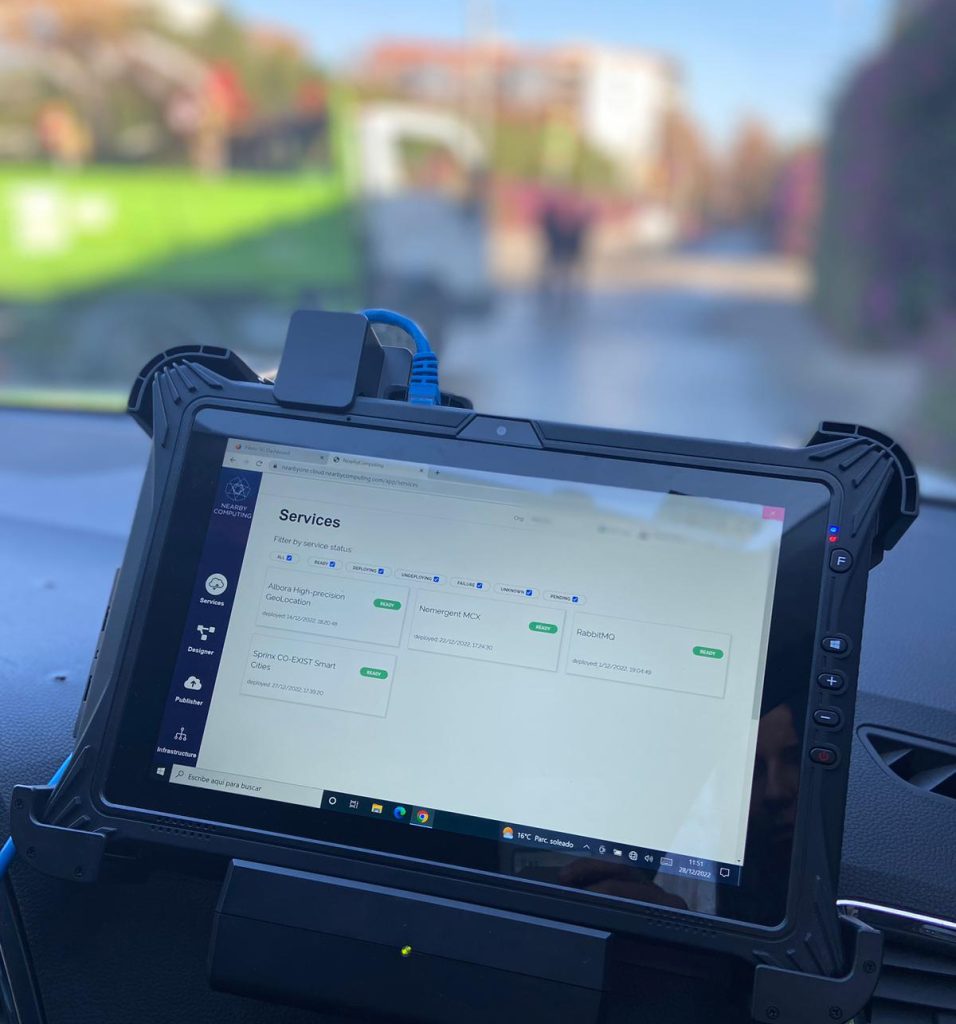- Cellnex Telecom and Nearby Computing, two of the eight partners of UTE 5G Catalunya, coordinated the demonstration of this use case by 5G Catalunya, one of the 5G pilot development grants awarded by Red.es.
- The ‘Guardia Urbana’, Municipal I.T. Institute of the Barcelona City Council and various start-ups like Albora Technologies, Nemergent Solutions and Sprinx Technologies collaborated to develop this use case.
The 5G Catalunya pilot project has demonstrated a 5G networks use case to better manage emergencies, traffic and public safety. Cellnex Telecom and Nearby Computing led the project using Lenovo technology, with the collaboration of the Barcelona Urban Police force (Guardia Urbana), Municipal I.T. Institute of the Barcelona City Council and various start-ups providing end applications.
The demonstration took place at the confluence of Avinguda Diagonal, Carrer Pere IV and Carrer Lope de Vega in Barcelona’s Poblenou neighbourhood. The collaboration of the Guardia Urbana –which provided descriptions of their usual operations so that they could be improved with 5G– was key to the project’s development. In addition to 5G terminals, five security cameras were installed on three streetlights and connected to a control centre managed by the Guardia Urbana.
The use case involved testing Stand Alone (end-to-end) and Open Ran (open standard) 5G networks for a complex web of devices and applications which, thanks to the features offered by this new wideband and real-time technology, will make it possible to manage emergencies and traffic better and monitor officers’ safety whilst on duty. Specifically, based on today’s demonstration, 5G networks can help to prevent critical situations by making it easier for emergency teams to respond quickly. By providing access to multiple sources of information, the networks optimise and speed up decision-making in critical situations where time is of the essence and access to all information is decisive.

Multiple use cases in one
The project included several use cases in one:
- Real-time vision. Five security cameras aimed at the intersection of the three streets and connected to the 5G network provided images for traffic management. Sprinx Technology’s video analysis technology was used on the camera images, making it possible to count vehicles, analyse traffic flows, issue automatic congestion alerts and even manage traffic automatically based on the imperatives of actual vehicle flow and other factors.
- Managing real-time alerts. With automated video analytics, the cameras can also detect emergencies (the use case demo used a car stopped on the Diagonal tramway tracks) and generate alerts which are sent to the control centre, officers or vehicles closer to the incident. Further, on receiving the message, officers can connect via mobile phone to the video-camera feed to see what is happening at that location in real time. The latter application makes managing emergencies easier, since relevant information from the images allows for responses that are more coordinated and efficient.
- Improved communication between law enforcement agencies. In parallel, the use case showed how 5G networks can deliver substantial improvements in communication between officers. Existing closed-circuit audio transmitters were replaced with 5G devices that use technology from Albora Technologies to guarantee reliable and encrypted group audio and video calls, live streamed images from officers’ body cameras and GPS tracking with a margin of error of only one metre (compared to the 10 metre margin of error offered by current networks).
- Monitoring officers’ physical condition. Likewise, the 5G Catalunya pilot demo used a heart-rate sensor to monitor officers’ status. The data from this device provide information on physical activity and make it possible to detect, for example, when an officer is running or in a stressful situation. When the normal established heart rate is exceeded, the device emits an alert that can be received in the control centre, informing an individual’s colleagues of his exact location. They can also connect to the officer’s bodycam to understand the situation in which he is involved. Beyond heart rate sensors, 5G networks make it possible to connect other similar devices to monitor officers’ safety.
- Sharing information with the vehicles involved. Lastly, with state-of-the-art tablets, officers can also access all this information –today mainly limited to voice communication, GPS maps and the order dispatching service– from vehicles. Moreover, the 5G Catalunya pilot project proposes technologies that eliminate the current 48-hour wait period on vehicle software updates.

In real time and a reliable environment
5G networks therefore make it possible to manage devices remotely and transmit data and video with minimal latency and in near real time, which is key in emergency management. Additionally, high bandwidth and artificial intelligence processed across edge computing servers mean that law enforcement agencies will be able to anticipate, detect and analyse situations and make decisions efficiently and effectively in a secure, hierarchical and traceable resource-sharing environment made possible by edge computing technology and system orchestration.
Ana Varela, leader of the 5G Catalunya pilot project and Open Innovation Programme Manager at Cellnex Telecom, said, “From an innovation perspective this use case is a very complete experiment, because it simulates various scenarios of standard Guardia Urbana operations in a city environment, and shows how 5G network capabilities can deliver a set of functional improvements –in prevention, analysis and rapid intervention– which are very relevant for security and emergency management.”
Josep Martí, CEO of Nearby Computing, highlighted the importance of coordination and communication between all actors: “The system connecting the control centre, vehicles, officers on foot, security cameras and other possible sources of information must be automated, flexible and operate over a reliable, real-time network with sufficient bandwidth like 5G. All this is possible thanks to a unified and flexible management that orchestrates systems and applications like the one carried out by our NearbyOne platform, over the network operated by Cellnex.”
About 5GCat
5G Catalunya was one of the winners of the second call for funds to develop 5G pilots that was launched at the end of 2019 by Red.es —an entity of the Ministry of Economic Affairs and Digital Transformation— within the National 5G Plan. The initiative is co-financed by the European Regional Development Fund (ERDF).
5G Catalunya is developed by a consortium of eight companies led by Cellnex Telecom and the Masmovil Group, along with Catalan operator Parlem Telecom, Increase Solutions, a company specialised in augmented reality for industry, engineering company Atos, Nae consultants, technological company Lenovo and the Nearby Computing start-up, a spin-off of the Barcelona Supercomputing Center. In addition, the project is supported by the Mobile World Capital Barcelona Foundation.
The pilot consists of seven use cases aimed at developing 5G-based solutions for urban environments, specifically in mobility, remote education, the industrial sector, remote procurement, audiovisual transmission, management of security and emergencies and connectivity in areas with high seasonal occupancy.
The aim of executing these seven use cases is to drive digital transformation in distinct areas of people’s lives, helping to cement implementation of a technological ecosystem that will undoubtedly act as a lever for development at both a social and economic level.

